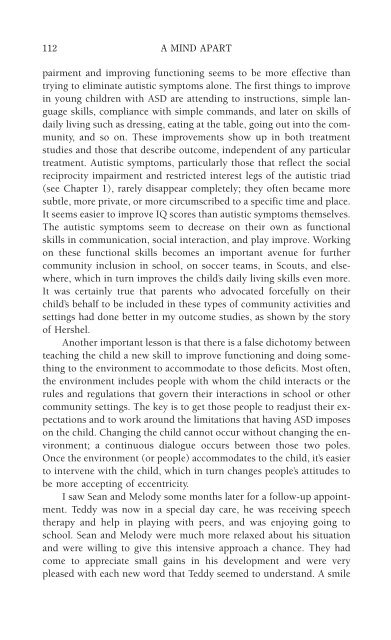978-1572305441
autism
autism
Create successful ePaper yourself
Turn your PDF publications into a flip-book with our unique Google optimized e-Paper software.
112 A MIND APART<br />
pairment and improving functioning seems to be more effective than<br />
trying to eliminate autistic symptoms alone. The first things to improve<br />
in young children with ASD are attending to instructions, simple language<br />
skills, compliance with simple commands, and later on skills of<br />
daily living such as dressing, eating at the table, going out into the community,<br />
and so on. These improvements show up in both treatment<br />
studies and those that describe outcome, independent of any particular<br />
treatment. Autistic symptoms, particularly those that reflect the social<br />
reciprocity impairment and restricted interest legs of the autistic triad<br />
(see Chapter 1), rarely disappear completely; they often became more<br />
subtle, more private, or more circumscribed to a specific time and place.<br />
It seems easier to improve IQ scores than autistic symptoms themselves.<br />
The autistic symptoms seem to decrease on their own as functional<br />
skills in communication, social interaction, and play improve. Working<br />
on these functional skills becomes an important avenue for further<br />
community inclusion in school, on soccer teams, in Scouts, and elsewhere,<br />
which in turn improves the child’s daily living skills even more.<br />
It was certainly true that parents who advocated forcefully on their<br />
child’s behalf to be included in these types of community activities and<br />
settings had done better in my outcome studies, as shown by the story<br />
of Hershel.<br />
Another important lesson is that there is a false dichotomy between<br />
teaching the child a new skill to improve functioning and doing something<br />
to the environment to accommodate to those deficits. Most often,<br />
the environment includes people with whom the child interacts or the<br />
rules and regulations that govern their interactions in school or other<br />
community settings. The key is to get those people to readjust their expectations<br />
and to work around the limitations that having ASD imposes<br />
on the child. Changing the child cannot occur without changing the environment;<br />
a continuous dialogue occurs between those two poles.<br />
Once the environment (or people) accommodates to the child, it’s easier<br />
to intervene with the child, which in turn changes people’s attitudes to<br />
be more accepting of eccentricity.<br />
I saw Sean and Melody some months later for a follow-up appointment.<br />
Teddy was now in a special day care, he was receiving speech<br />
therapy and help in playing with peers, and was enjoying going to<br />
school. Sean and Melody were much more relaxed about his situation<br />
and were willing to give this intensive approach a chance. They had<br />
come to appreciate small gains in his development and were very<br />
pleased with each new word that Teddy seemed to understand. A smile



